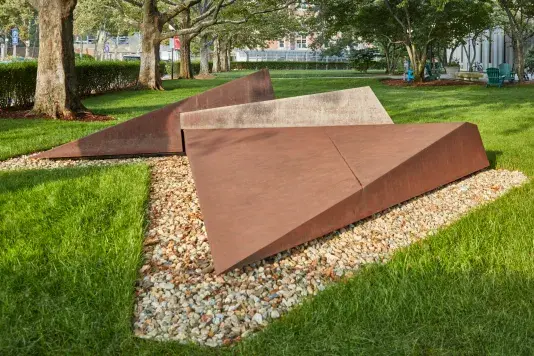Beverly Pepper, Trinity, 1971. Gift of the Sonnabend Foundation. Photo: Charles Mayer Photography
Trinity, 1971

Beverly Pepper’s early sculptures of the 1960s were made of wood, Cor-Ten steel, and stainless steel.
Many of her works in steel are highly polished to reflect the landscape and the viewer and lend an illusory sense of weightlessness to the massive structures. Because these monumental forms are streamlined, factory-fabricated, and often modeled on geometric solids, critics sometimes associated Pepper’s early work with Minimalism, but such a link mistook her intentions. In contrast to that movement’s agenda of providing unambiguous and impersonal visual information, Pepper’s sculptures are intended to carry sexual, spiritual, and emotional connotations.
Trinity is composed of three intersecting pyramidal forms of decreasing sizes that hug both the ground and each other. The lapping planes suggest both protection and subtle aggression, stability and flow. These tensions are heightened by the work’s rusted surface, which suggests age and stasis, in contrast to its form, which seems to demonstrate a process of growth and transformation. Pepper fostered this metamorphosis, in part, by revising the work’s title in 1986. The sculpture’s original title, Dunes I, may have alluded to the low, planar patterns of sand shaped by the natural force of wind, while the current title is more evocative of a religious sense of unity. This shift in meaning exemplifies how Pepper’s abstract aesthetic language can be read in myriad ways.
Beverly Pepper (1922–2020) was born in Brooklyn, New York. After studying design at the Pratt Institute she worked as a commercial art director. She then briefly studied at the Art Students’ League and at Brooklyn College, where she attended courses with György Kepes. Pepper left the United States in 1949 to study painting in Paris at the Académie de la Grande Chaumière under Fernand Léger. Although she returned one year later, Pepper continued to travel extensively throughout Europe and Asia; one of her most influential trips was a 1960 visit to Angkor Wat in Cambodia, about which she said, “I walked into Angkor Wat a painter and I left a sculptor.” From that point on, she began to experiment with geometric form and space as well as natural and industrial materials. Characterized by their monumentality, superhuman scale, and strong verticality, these works rely on the interplay between solidity and emptiness, space and void, sleek form and raw material. Pepper exhibited her work in hundreds of shows over her lifetime, and her sculptures are in the collections of museums and institutions including the Metropolitan Museum of Art, New York; Corcoran Gallery of Art, Washington, D.C.; University of Michigan; Dartmouth College, Hanover, New Hampshire; Museum of Fine Arts, Boston; Fogg Museum, Cambridge; and Art Gallery of Ontario, among many others. Pepper worked in both New York and Spoleto, Italy, where she lived for more than fifty years. She died in 2020.